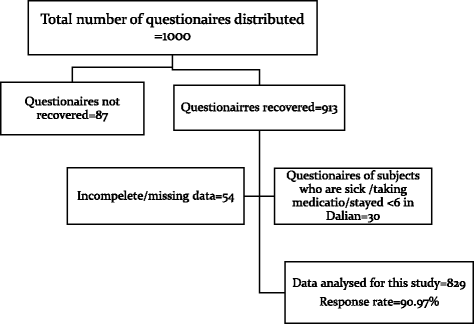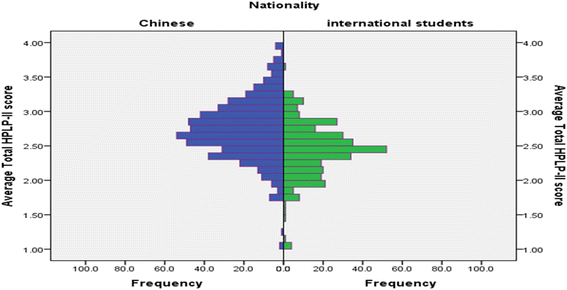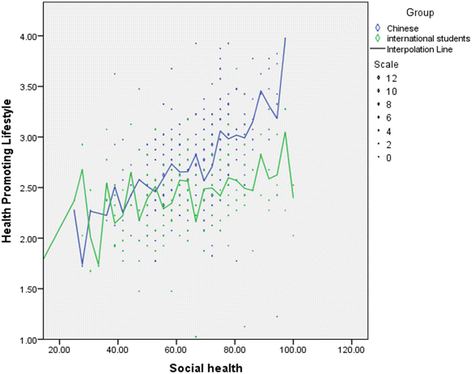Do socio-cultural factors influence college students' self-rated health status and health-promoting lifestyles? A cross-sectional multicenter study in Dalian, China
- PMID: 28525995
- PMCID: PMC5438535
- DOI: 10.1186/s12889-017-4411-8
Do socio-cultural factors influence college students' self-rated health status and health-promoting lifestyles? A cross-sectional multicenter study in Dalian, China
Abstract
Background: An unhealthy lifestyle of college students is an important public health concern, but few studies have been undertaken to examine the role of socio-cultural differences.
Methods: For this cross-sectional comparative study, data on college students' health-promoting lifestyles (HPL), as measured using the Health-Promoting Lifestyle Profile (HPLP-II) scale, and self-rated health status (SRH) as measured by Sub-Optimal Health Measurement Scale (SHMS V1.0) were collected from 829 college students.
Results: The sample of 829 college students included 504 (60.8%) Chinese and 325 (39.2%) international students. Chinese students had higher scores in overall health-promoting lifestyle (HPL) (P < 0.001, eta squared =0.113) and in all the six subclasses than their international counterparts. In relation to health status evaluation, the two groups varied in physiological health (P < 0.001, eta squared = 0.095) and social health (P = 0.020, eta squared = 0.007) but there was no significant difference in psychological health subscale (P = 0.156, eta squared = 0.002). HPL was predicted by financial status among the Chinese group and by student's major, age and level of education in the international group. Body mass index (BMI) and financial status emerged as predictors of the three subscales of SHMS V1.0 in the Chinese group and also of physiological and psychological subscales in the international group. Gender was associated with psychological health in both groups. Smoking status was a predictor of psychological health in both groups and also of social health in the international group. The level of education emerged as a predictor of social health in the international group. Regression analyses revealed a significant association between health status and healthy lifestyle (P < 0.001). In reference to participants with "excellent" lifestyle, participants with moderate lifestyle were at a 4.5 times higher risk of developing suboptimal health status (SHS) (OR: 4.5,95% CI:2.2-9.99) and those with a 'general' lifestyle were at a 3.2 times higher risk SHS (OR: 3.2, 95% CI: 1.5-7.18). Good and moderate HPLP-II levels of nutrition are associated with low risk of suboptimal health status (OR: 0,41 and 0,25, respectively). Participants in good and moderate HPLP-II levels of interpersonal relations are associated with higher risk of suboptimal health (OR:2,7 and 3,01 respectively) than those in excellent levels of HPLP-II.
Conclusion: Collectively, these findings provide a convincing body of evidence to support the role of socio-cultural factors as key determinants of the HPL and SRH of college students.
Figures
Similar articles
-
The Role of Healthy Lifestyle in the Implementation of Regressing Suboptimal Health Status among College Students in China: A Nested Case-Control Study.Int J Environ Res Public Health. 2017 Feb 28;14(3):240. doi: 10.3390/ijerph14030240. Int J Environ Res Public Health. 2017. PMID: 28264509 Free PMC article.
-
[Associations between health-promoting lifestyle and suboptimal health status in Guangdong: a cross sectional study].Nan Fang Yi Ke Da Xue Xue Bao. 2016 Apr;36(4):538-43. Nan Fang Yi Ke Da Xue Xue Bao. 2016. PMID: 27113183 Chinese.
-
[Effect of health-promoting lifestyle on outcomes of suboptimal health status].Nan Fang Yi Ke Da Xue Xue Bao. 2016 Feb 20;37(2):184-191. doi: 10.3969/j.issn.1673-4254.2017.02.07. Nan Fang Yi Ke Da Xue Xue Bao. 2016. PMID: 28219861 Free PMC article. Chinese.
-
Changes in Chinese adolescent college students' psychological security during 2004-2020: A cross-temporal meta-analysis.J Adolesc. 2023 Jun;95(4):631-646. doi: 10.1002/jad.12147. Epub 2023 Feb 7. J Adolesc. 2023. PMID: 36751136 Review.
-
Stress, Anxiety, and Weight Gain among University and College Students: A Systematic Review.J Acad Nutr Diet. 2018 Feb;118(2):261-274. doi: 10.1016/j.jand.2017.10.015. J Acad Nutr Diet. 2018. PMID: 29389509
Cited by
-
Associations of physical activity and screen time with suboptimal health status and sleep quality among Chinese college freshmen: A cross-sectional study.PLoS One. 2020 Sep 18;15(9):e0239429. doi: 10.1371/journal.pone.0239429. eCollection 2020. PLoS One. 2020. PMID: 32946516 Free PMC article.
-
Health-promoting lifestyle and its predictors among health-related and non-health-related university students in Taiwan: a cross-sectional quantitative study.BMC Public Health. 2023 May 5;23(1):827. doi: 10.1186/s12889-023-15760-2. BMC Public Health. 2023. PMID: 37147650 Free PMC article.
-
Impact of family doctor contracted services on the health of migrants: a cross-sectional study in China.Sci Rep. 2024 Nov 27;14(1):29510. doi: 10.1038/s41598-024-81068-9. Sci Rep. 2024. PMID: 39604578 Free PMC article.
-
Lifestyle Practices, Satisfaction with Life and the Level of Perceived Stress of Polish and Foreign Medical Students Studying in Poland.Int J Environ Res Public Health. 2020 Jun 20;17(12):4445. doi: 10.3390/ijerph17124445. Int J Environ Res Public Health. 2020. PMID: 32575794 Free PMC article.
-
Associations Between Sociodemographic Characteristics, eHealth Literacy, and Health-Promoting Lifestyle Among University Students in Taipei: Cross-Sectional Validation Study of the Chinese Version of the eHealth Literacy Scale.J Med Internet Res. 2024 Jul 18;26:e52314. doi: 10.2196/52314. J Med Internet Res. 2024. PMID: 39024006 Free PMC article.
References
Publication types
MeSH terms
LinkOut - more resources
Full Text Sources
Other Literature Sources
Medical
Research Materials




